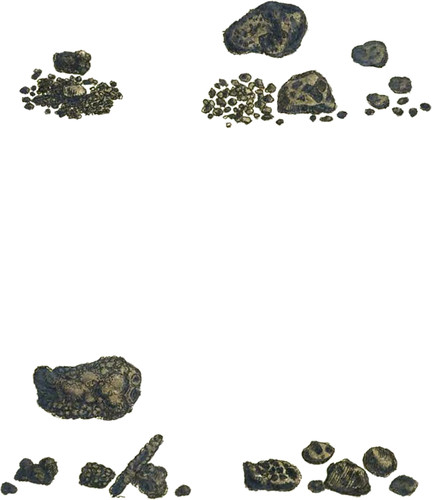 Enlarge
Enlarge
Exotic Mineralogy
Native Platinum
- Syn.
- Platine natif ferrifére. Haüy, Tabl. 72. Traité 3. 368.
- Platine ou Or blanc. De Lisle, 3. 487.
- Gidiegen Platin. Emmerl. 2. 106.
- Platina. Kirwan, 2. 203.
This curious and valuable Metal, of modem discovery,* has many remarkable properticsj but nothing in its ores to give attractive beauty to its figure; they are, however, sufficiently marked to be identified. There have been found hitherto only two, both of which are in the form of small grains. The most common is that brought from the neighbourhood of Peru, and is the kind used in commerce. It consists of grains usually very small, rarely as large as peas; it is mixed with crystals of Magnetic Iron, grains of Ferriferous Titanium or Menachanite, minute Zircons, grains of gold, and of the ore of Iridium, and rarely crystals of Muriate of Copper. The Gold is usually separated by Mercury. The grains of Platinum are generally of a flattish form, with a worn surface; the larger ones show numerous angular hollows, and sometimes enclose crystals of Iron, and flakes of the ore of Iridium. Their colour is between that of Lead and Silver, their hardness and ductility considerable, and they are nearly infusible. Spec. Grav. 17.7. They contain, besides Platinum, about fifteen per cent, of Iron, and small portions of six other metals, viz. Copper, Lead, Iridium, Osmium, Palladium, and Rhodium.
The other kind of Platinum has lately been brought from the Brazils; the grains are about the same size as those from Peru, but they differ in form, as Dr. Wollaston has observed, having numerous convexities, or protuberances, in place of hollows upon their surfaces. They appear to be formed of several coats, one over the other; many of the smaller grains are merely hollow spheres, others are tubular; the larger ones are mamillated on their surface, dull, and but little worn: in colour they approach more to silver than the other Platinum does. They are composed of nearly pure Platinum, and are accompanied by native Palladium.
To our countryman, the ingenious and acute Dr. Wollaston, we are indebted for the fine specimens and analysis of these substances: that from the Brazils is extremely rare in this country.
The upper right-hand figure represents the pure Platinum from the Brazils, of the natural size; beneath are several of the same grains magnified. The left-hand figures show the ferriferous, or Peruvian Platinum, the lower ones being several of the small grains magnified; larger grains than the upper ones have never perhaps been found.
We attempted to use Platinum itself to colour the figures, but found it by far too black when in powder; to imitate the lights tolerably well we have therefore been obliged to use Silver, although we are aware that it will tarnish.
- * Comparatively to the more usual metals; it is supposed not to have been known before the year 1749.

